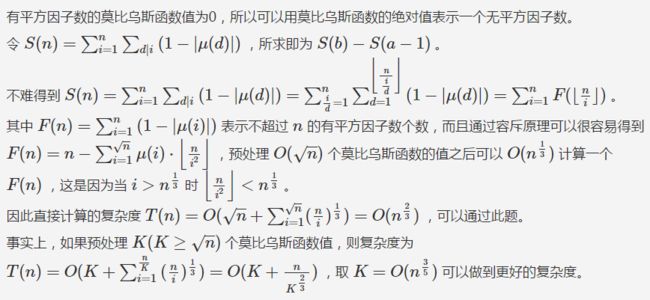每周训练 题解
#A
从题目的第一行中可以很容易看出,这题用的是扩展欧几里得算法 i ∗ a + j ∗ b = n + 1 i*a+j*b=n+1 i∗a+j∗b=n+1,因为要保证 i ∗ a i*a i∗a, j ∗ b j*b j∗b为正整数,所以i,j必须为正整数。所以这题就求i,j的解为正整数的解的个数。没有看着来说明你对这个算法还不够了解。
求正整数解的个数的时候我是求出i的最小正整数解,再用i求出对应的j,接下来假设我们让i增加(i必然满足情况),那么j必然减小,所以让j除以j的每次的减少量,就可以直接的求出正整数解的个数。注意0不能取。
#include
#define pi acos(-1)
#define pb push_back
#define LL long long
#define lson l , m , rt << 1
#define rson m + 1 , r , rt << 1 | 1
#define local freopen("in.txt","r",stdin)
#define input_fast std::ios::sync_with_stdio(false);std::cin.tie(0)
using namespace std;
const int mod = 1e9 + 7;
const int INF=0x7FFFFFFF;
inline void read(int& x){
int flag = 1; char c; while(((c = getchar()) < '0' || c > '9') && c != '-');
c == '-' ? (flag = -1, x = 0) : (x = c - '0');
while((c = getchar()) >= '0' && c <= '9') { x = x * 10 + c - '0'; } x *= flag;
}
void exgcd(LL a, LL b, LL &d, LL &x, LL &y){
if(b == 0){ d = a; x = 1; y = 0; return;}
exgcd(b, a % b, d, y, x); y -= a / b * x;
}
int main(){
input_fast;
//local;
int t; LL n, a, b, d, x, y; cin >> t; while(t--){
cin >> n >> a >> b; ++n;
exgcd(a, b, d, x, y);
if(n % d){ cout << 0 << endl; continue;}
x *= n / d; x = (x % (b / d) + b / d) % (b / d);
if(x == 0) x += b / d;
y = (n - x * a) / b;
if(y <= 0) cout << 0 << endl;
else cout << y / (a / d) + (y % (a / d) ? 1 : 0) << endl;
}
return 0;
}
抛开这个题我们发现题目给的集合就是a,b都为1时的正整数解集,当a,b取不同值可能导致解集缩小(成为它的子集,虽然这样说不严谨),想想这个有助于你理解扩展欧几里得求通解的过程。
#B
N(n)就是[Partition](https://en.wikipedia.org/wiki/Partition_(number_theory)
我们从中发现了 和
和 再结合题目中给的公式,就可以得出 x n x^n xn的系数序列为1,-1,-1,0,0,1,0,1···,而x的幂的取值为 k ( 3 k + 1 ) / 2 k(3k+1)/2 k(3k+1)/2,k为0,-1,1,-2,2···,具体工程看代码。
再结合题目中给的公式,就可以得出 x n x^n xn的系数序列为1,-1,-1,0,0,1,0,1···,而x的幂的取值为 k ( 3 k + 1 ) / 2 k(3k+1)/2 k(3k+1)/2,k为0,-1,1,-2,2···,具体工程看代码。
#include
#define pi acos(-1)
#define pb push_back
#define LL long long
#define lson l , m , rt << 1
#define rson m + 1 , r , rt << 1 | 1
#define local freopen("in.txt","r",stdin)
#define input_fast std::ios::sync_with_stdio(false);std::cin.tie(0)
using namespace std;
const int INF = 0x7FFFFFFF;
const int mod = 1e9 + 7;
inline void read(int& x){
int flag = 1; char c; while(((c = getchar()) < '0' || c > '9') && c != '-');
c == '-' ? (flag = -1, x = 0) : (x = c - '0');
while((c = getchar()) >= '0' && c <= '9') { x = x * 10 + c - '0'; } x *= flag;
}
int a[52000], cnt;
void init(){
a[cnt++] = 0;
for(int i = 1; true; ++i){
a[cnt++] = (-i) * ((-i) * 3 + 1) / 2;
if(a[cnt - 1] >= mod) break;
a[cnt++] = i * (i * 3 + 1) / 2;
if(a[cnt - 1] >= mod) break;
}
//cout << cnt << endl; 51641
}
LL power(LL a, int b){
LL res = 1;
while(b){
if(b & 1) res = (res * a) % mod;
a = a * a % mod; b >>= 1;
}
return res;
}
int main(){
input_fast;
init();
int t, base, n, coe, index; LL ans = 0; read(t); read(base);
for(int i = 1; i <= t; ++i){
read(n);
index = lower_bound(a, a + cnt, n) - a;
if(a[index] == n){ if(index % 4 == 0 || index % 4 ==3) coe = 1; else coe = -1;}
else coe = 0;
if(coe == 1) ans = (ans + power(base, t - i)) % mod;
else if(coe == -1) ans = (ans + 998244352 * power(base, t - i)) % mod;
}
cout << ans << endl;
return 0;
}
#C
题解的证明,我还没有理解,大家先凑合看

#D
这题我挂错了
#E
n堆糖果,每人可以从一堆中取任意多个(大于0)或者把一堆分成三堆,所以
sg(0)=0,
sg(1)=1,
sg(2)=2,
sg(3)=3
。
。
。
sg(7)=8;
sg(8)=7;
sg(9)=9;
。
。
。
sg(8k+1)=8k+1,
sg(8k+2)=8k+2,
.
.
.
sg(8k+7)=8k+8,
sg(8k+8)=8k+7,k>=0;
同样分成两堆的时候是
sg(4k+1)=4k+1,
sg(4k+2)=4k+2,
.
.
.
sg(4k+3)=4k+4,
sg(4k+4)=8k+3,k>=0;